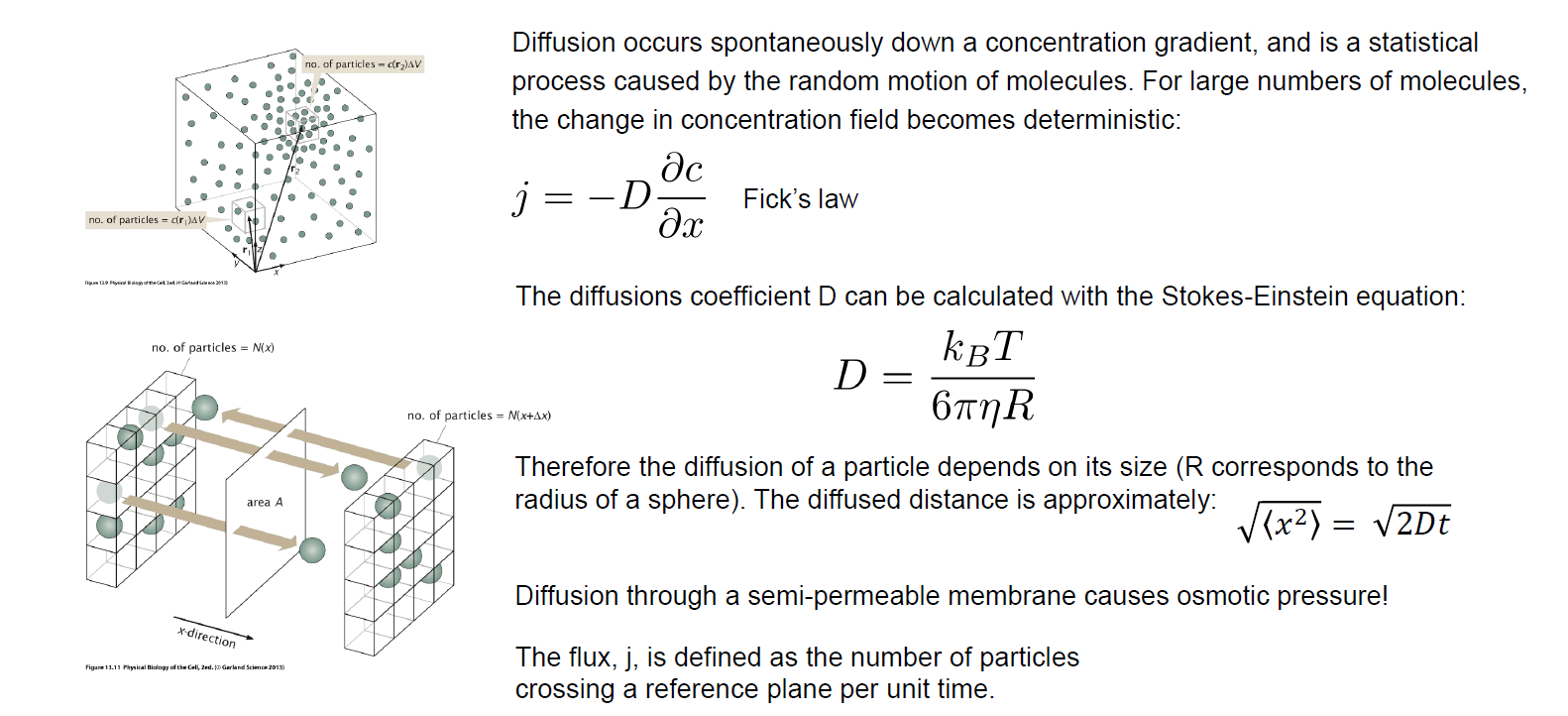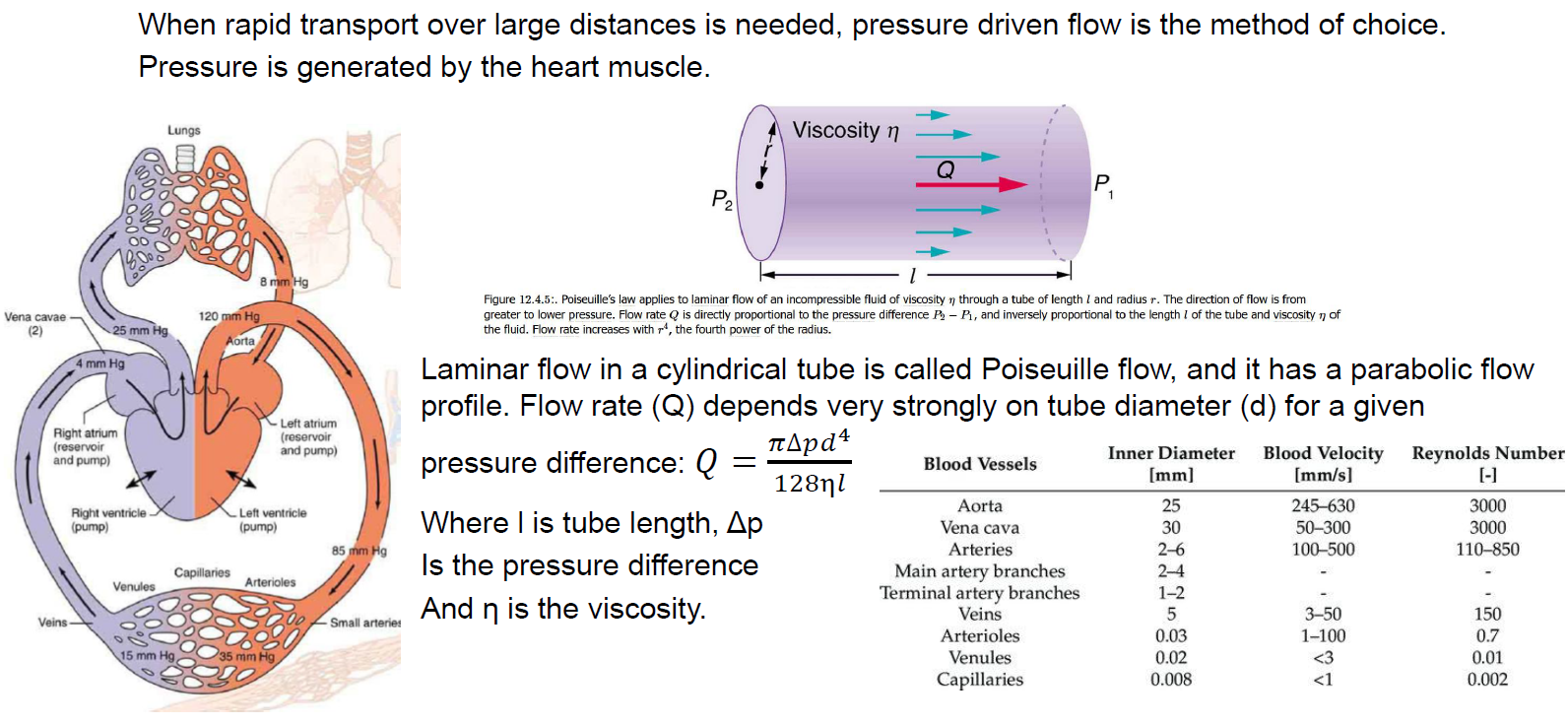BIO 1 - The physical basis of living systems
1/17
There's no tags or description
Looks like no tags are added yet.
Name | Mastery | Learn | Test | Matching | Spaced |
|---|
No study sessions yet.
18 Terms
Diffusion
Diffusion is the passive movement of molecules or particles from an area of higher concentration to an area of lower concentration, driven by the concentration gradient.
Diffusion flux (Ficks law):
j = -D * dc/dx
Diffusion constant:
D = (k_B * T)/(6 pi µ R)
Diffusion distance:
sqrt(x²) = sqrt(2Dt)


Osmotic pressure
is the pressure required to prevent the flow of water across a semipermeable membrane due to solute concentration differences.
Π = c R T

Pressure-driven flow (laminar)
is the movement of fluid through a conduit or around objects in a smooth, orderly manner, typically occurring in conditions of low viscosity and under a constant rate of flow.
Q = (π Δp d^4)/(128 µ l)

Capillarity
is the ability of a liquid to flow in narrow spaces without the assistance of external forces, often observed in plants as water moves through small tubes or vessels.
h = (2 γ cos(θ)/(ρ g r_0)
Where:
theta = contact angle
gamma = surface tension

Why is water important for life? What properties make it so special?
Water is essential for life due to its unique chemical and physical properties:
Solvent ability: It dissolves many biomolecules, enabling biochemical reactions.
Cohesion and adhesion: Allows capillary action (e.g., water transport in plants).
High heat capacity: Stabilizes temperature in living systems.
Ice floats: Prevents total freezing of water bodies, allowing aquatic life.
Facilitates biochemical reactions: Water is involved in hydrolysis and condensation reactions.
What are requirements for life as we know it?
Liquid water (universal solvent)
Source of energy (sunlight, chemical gradients)
Carbon-based chemistry (forms complex molecules)
Ability to replicate and evolve (genetic material)
Stable environment (not too extreme)
What are the basic characteristics of living systems and why are viruses often not considered alive?
Basic characteristics of life:
Organization (cells)
Metabolism (energy processing)
Homeostasis (regulation of internal conditions)
Growth & Development
Response to stimuli
Reproduction
Evolution
Viruses lack:
Independent metabolism.
Cellular structure.
Self-replication (they need a host).
Thus, they are often classified as biological entities rather than life forms.
How can we remotely find signs of life on exoplanets?
Biosignatures in atmospheres: Oxygen, methane, carbondioxide, ozone, and their disequilibrium states.
Surface reflectance: Pigments like chlorophyll (red-edge effect).
Temporal variations: Seasonal gas cycles.
Non-equilibrium chemistry: Presence of gases that should chemically react away.
Planets in a Goldilock-zone
What are examples of how living organisms can generate large scale geological structures?
Coral reefs: Built by corals depositing calcium carbonate.
Limestone deposits: Formed by ancient marine organisms.
Stromatolites: Layered structures by cyanobacteria.
Soil formation: Microbes contribute to rock weathering.
Methane deposits: Produced by microbial activity in sediments.
What is the role of ATP? How much of it are we producing? Be able to perform simple stoichiometric calculations of energy conversion.
ATP (Adenosine Triphosphate) is the primary energy carrier in cells.
Each human cell uses ~10 million ATP molecules per second.
Daily ATP turnover in humans: ~50–75 kg (despite only having ~250 g of ATP at any time).
Stoichiometric Calculation Example: Glucose oxidation:
C6H12O6 + 6O2 —> 6CO2 + 6H2O + 38ATP
Each mole of glucose (~180 g) produces ~38 moles of ATP.
What forms of energy does life use and how is energy stored in live cells?
Energy sources:
Phototrophy: Sunlight (e.g., photosynthesis).
Chemotrophy: Chemical reactions (e.g., sulfur bacteria).
Storage:
ATP (short-term energy)
Glycogen, Starch (carbohydrate storage)
Lipids (long-term energy storage) (Fat)
What is an argument for the RNA-world hypothesis of the origin of life?
RNA can store genetic information AND catalyze reactions (ribozymes).
Some modern enzymes still rely on RNA (e.g., ribosome function).
Self-replicating RNA molecules can evolve without proteins.
RNA fragments can be synthesized spontaneously in lab conditions.
Which basic properties of living systems are constrained by physical laws.
Diffusion limits: Affects cell size (nutrient transport scales with surface area).
Thermodynamics: Energy must be conserved; life must increase entropy in surroundings.
Human in thermal equilibrium = dead
Fluid dynamics: Influences blood circulation, plant water transport.
Scaling laws: Metabolic rates follow Kleiber’s law (M^(3/4)).
Why are dissipative structures relevant for understanding life?
Dissipative structures maintain order by increasing entropy in the surroundings.
Examples:
Hurricanes (self-organized patterns)
Bénard convection cells
Living organisms (consume energy, export waste heat)
Life exists far from equilibrium and requires a constant energy flow.
How can diffusion lead to pattern formation?
Turing Patterns: Chemical gradients + reaction kinetics create spots, stripes (e.g., zebra stripes, fish patterns).
Morphogenesis: Diffusion of morphogens determines body plans (e.g., limb development).
Give examples for biological properties governed by universal scaling laws.
Metabolic rate:
B ∝ M^3/4
Where:
B: basal metabolic rate
M: body mass
Heart rate:
f ∝ M^-1/4
Life span:
L ∝ M^1/4
How do biological magnetoreception and temperature sensing work?
Magnetoreception: Some animals (birds, turtles) use magnetite-based or quantum-coherent mechanisms to detect Earth's magnetic field.
Temperature sensing: TRP channels respond to heat/cold; some snakes have infrared sensors.
TRP channels (short for Transient Receptor Potential channels) are a large family of ion channels found in many animal cells, especially sensory neurons. They play crucial roles in detecting and responding to environmental stimuli such as temperature, pain, pressure, and chemicals.
What is chemotaxis?
Chemotaxis is movement in response to a chemical gradient.
Example: Bacteria like E. coli move toward nutrients (like glucose) and away from harmful substances.
How it works:
Bacteria have flagella that help them swim.
They alternate between:
"Run" – swimming straight
"Tumble" – changing direction randomly
If they sense they're moving toward something good (like more glucose), they run longer and tumble less.
If it's getting worse, they tumble more to find a better direction.